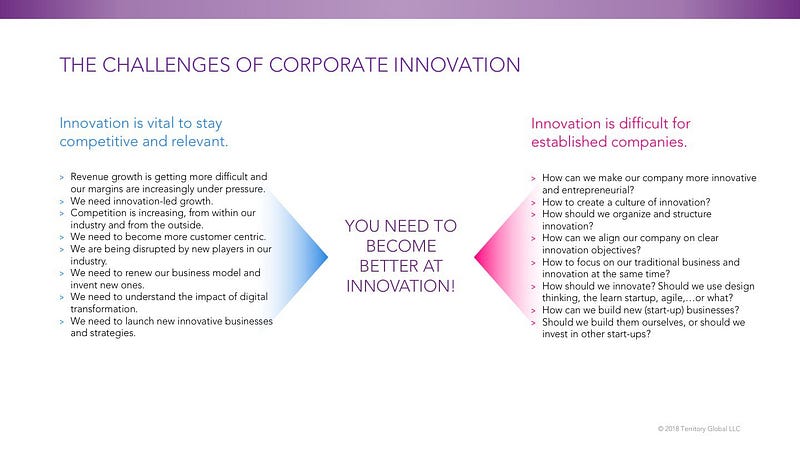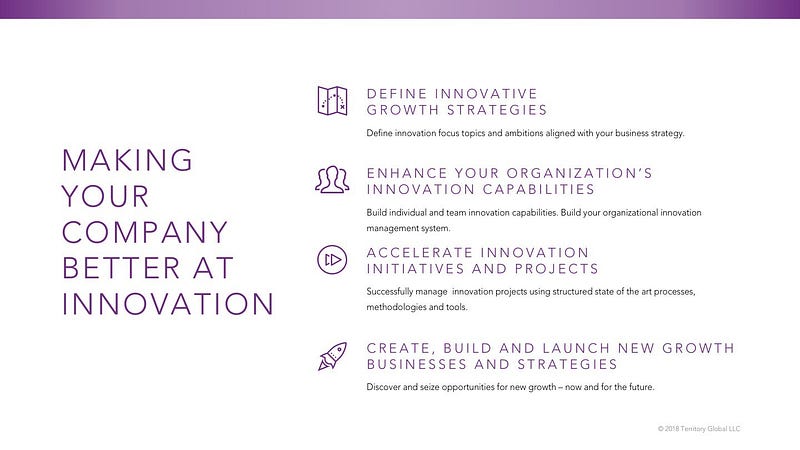How to make your company succeed at innovation
A Holistic Approach is Effective
Monday, September 25, 2023
I bet you are frustrated by your company’s innovation efforts, aren’t you? At least, that is what I keep on hearing from executives. “How can we make our company succeed by being more innovative and entrepreneurial?”
“How to get more buy-in?”
“We’re not seeing any results”… and on and on and on…
By now, most executives have understood that corporate innovation is vital for their companies to stay relevant. We’ve all seen the Fortune 500 statistics about companies dying faster (The average lifespan of F500s is now under 20 years).
Considering all that has been said and written (a search on Amazon.com for “innovation” yields over 100,000 results) on innovation, one would think we have figured it out by now. Yet, companies are still struggling to succeed at innovation, and executives keep on expressing their frustration with the results or, rather, lack thereof, their innovation efforts yield. For a lot of companies, all the innovation workshops, innovation labs, design thinking studios, etc., have not had a major impact. The main problem with most approaches is that they try to outsource innovation. You either outsource it to consultants, or to a lab or a studio, which creates all sorts of problems (“not invented here”, “us vs. them”, “too far away from our business”), but mostly these approaches do not help to make your company, your organization, and your people better at innovation. Hence, despite all the efforts, the results and impact are not materializing.

If you sincerely believe innovation is required for your company to stay relevant, your organization needs to become better at it. And here’s what it takes to make your company succeed at innovation.
Solving the corporate innovation challenges (see graph above) requires you to take a holistic approach. A single solution won’t do. This article outlines a framework to think holistically about your innovation efforts. Subsequent articles will go into the details of each area.
01 — DEFINE YOUR INNOVATION STRATEGY
First, you need to take a strategic approach to innovation. I often talk about “strategic innovation,” by which I mean, taking a strategic approach to innovation, and a more innovative approach to strategy altogether. The objective of strategic innovation is innovating new businesses and strategies for the future; it is about innovation-driven growth and renewal.
This means that you articulate innovation focus areas in line with your strategic objectives to achieve and strategic challenges to solve. Be it to find new growth, renew your company to become something else (BMW’s CEO talks about BMW becoming a technology company and a mobility provider), innovate new business models, or invent the future products and services of your business.
Defining your innovation strategy also means, defining where in your business, how much innovation is needed and expected, and how you will get it. It is simply unrealistic, and not functional, to expect your entire staff to be disruptive innovators. And you might not be capable of achieving everything on your own.
Defining focus areas and expectations is vital for your organization to understand why it should care about innovation and where to put its efforts.
02 — ENHANCE YOUR ORGANIZATION’S INNOVATION CAPABILITIES
Second, you need to focus on enhancing the innovation capabilities of your teams and your entire organization in line with your defined strategy.
This entails defining how you will set up, organize, and govern your innovation architecture and innovation management system. Building up an innovation core team or center of competence that brings experience, expertise, tools, and methods to innovation projects (see below), and how to foster innovation throughout the entire company.
Having defined your innovation focus areas and your expected level of innovation from various areas within your organization will help to prioritize your efforts. In one company, for example, we defined innovation targets and focus areas using the innovation ambition matrix, and then determined that the innovation core team would work on adjacent and transformational types of innovation, whereas the core and incremental kinds of innovation were to be run as local projects, facilitated by local innovation ambassadors, which were trained by the core team on an innovation approach suitable for these kinds of initiatives.
Enhancing your organization’s innovation capabilities will probably also require some change and transformation management, at least communicating throughout the organization why innovation is significant, what it means to your company, and how you will make it happen.
03 — ACCELERATE INNOVATION INITIATIVES AND PROJECTS
Evidence increasingly suggests that good innovation needs a structured and facilitated process. Your innovation core team should define what this process looks like for the various types of innovations and different innovation areas you have specified. The core team should be in charge of facilitating these processes and training people throughout the company on how to do this.
To enhance innovation capabilities throughout the company, you will need to staff these projects with people from throughout the business. The core team should not work in an isolated lab. People from throughout the enterprise could work, for example, for 3 or 6 months on innovation projects before going back to their regular jobs. They will have learned how to be innovative during this time and bring the toolset back to their department.
If you’re looking to show results and impact, this is the most crucial area, yet you need to have the above elements in place to make sure your innovation projects succeed, and the outcomes are appreciated by the company (because they contribute to strategic objectives and solve strategic challenges).
04 — CREATE, BUILD, AND LAUNCH NEW GROWTH VENTURES, BUSINESSES, AND STRATEGIES
The supreme innovation discipline. The ultimate impact and contribution innovation has to have is to show results in the form of new growth, new businesses, new business models, and unique competitive advantages. BMW’s vision is to “shape tomorrow’s premium mobility”. This vision leads their innovation efforts in cars (core), new mobility services (adjacent), new business models (a joint venture with Daimler for these mobility services — transformational), and utterly new mobility concepts for mega-cities (transformational).

CONCLUSION
To become better and make your company succeed at innovation, you need to take a holistic approach. This article presents a framework for areas to think about and address in your innovation efforts. To create impact and real innovation results, you will need to define innovation focus areas in line with your business strategy, enable people to accelerate innovation projects, and ultimately, your innovation efforts will need to create new growth ventures and strategies. In the following weeks, we’ll publish separate, detailed, articles on each of these areas and pertinent topics. Stay tuned!


